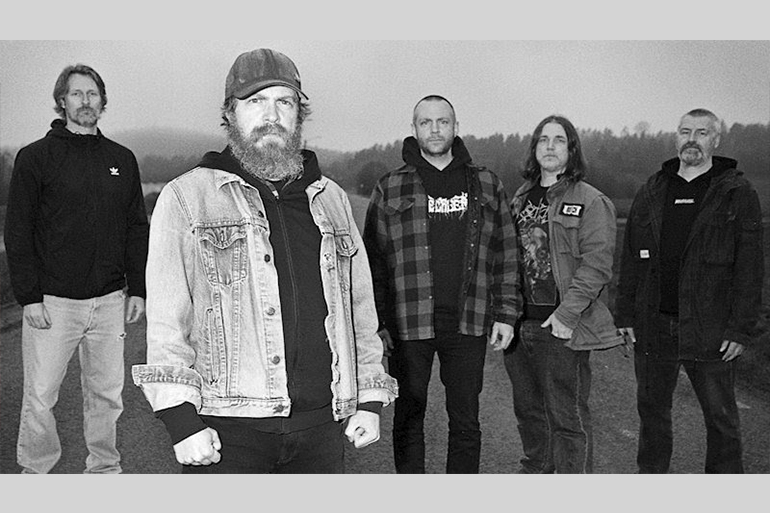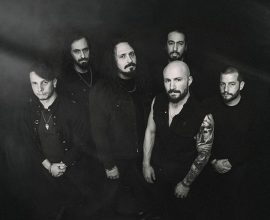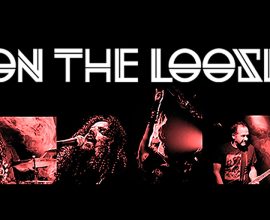“When everything burns down, there’s room for new growth”, UAAR about ‘Galger og Brann’
Emerging from the shadows of Norway’s underground scene, UAAR stands as a raw and relentless force, fusing decades of experience in punk, hardcore, and extreme metal. With their album Galger og Brann (“Gallows and Fire”), the band paints an apocalyptic soundscape — harsh, intense, and unflinching, where destruction and rebirth walk hand in hand. Sung in Norwegian and guided by a deeply DIY ethos, the record channels rage, frustration, and hope in the face of a collapsing world. Its lyrics invoke powerful symbols such as the gallows, fire, and the mythical figure of Den Siste (“The Last One”), representing both an inevitable end and the possibility of a new beginning.
By Sandra Pinto
In this interview, members Jon, Erik, Truls, and Stian discuss the creative process behind the album, the importance of maintaining full control over their art, the influences that shaped their devastating sound, and the belief that even among the ashes, there is still room to rebuild.
Galger og Brann translates to Gallows and Fire. What does this title represent in the context of the album’s themes?
Jon: The gallow and fire recur in several of the lyrics. The gallow represents the tool used for destruction of humankind as we know it, and fire represents the end, or conclusion. When the fire has burned everything down, there is nothing left. But when something has burned down, it also gives room for new growth.
How did the figure of Den Siste (“The Last One”) come about, and what does he symbolize in your music?
Jon: We have used different characters to symbolize different things in our lyrics since the first EP. So when we started to write lyrics for this album, we felt that the world was going in a downward spiral really fast, and something needed to happen.
Den Siste represents the world’s destructive process and the darkness that will change everything. He comes armed with his torch and rope and will destroy everything. His ways can be both the end or the beginning.
Your sound blends d-beat, crust, blackened hardcore, and death metal influences. How did you arrive at this intense fusion?
Jon: Hehe, just a lifelong passion for all kinds of heavy music. When we started the band, we wanted to create something fast and mean, and the combination of the five of us, just sounds like this. We take inspiration from everything we love about metal/hardcore/punk/rock and try to blend it as smoothly as possible.
UAAR is a deeply DIY band. What motivated you to take full control over every aspect of the album’s creation?
Erik: Some part of the DIY approach comes from skateboarding. Especially the art part of it, like Stian is a skateboard-photographer, I am a skateboard-videographer, and we all like the art that comes with skateboarding. Especially the darker part of it. So it comes naturally for us.
Truls: The DIY ethic and hardcore punk / metal are deeply intertwined. We are no different in that respect. We definitely appreciate the control when doing things ourselves, and also there’s a sense of comfort in DIY – especially when it comes to recording.
Jon: The five of us are a bunch of very creative people, with a lot of experience outside just music, so it falls natural for us and we just love to create things.
How does singing in Norwegian amplify the emotional weight of your lyrics compared to using English?
Jon: Dag and I were discussing it when we started to write lyrics for the band, and we both felt that it was easier to convey real anger in norwegian, both lyrically and performance-wise.
There’s a strong element of social and ecological critique in the album. What are the core messages you want listeners to take away?
Jon: Let your voice be heard against oppressive tendencies and forces, don’t tolerate the constant greed of humankind and don’t let the destruction of the world as we know it be the end, but a new beginning.
You describe the album as being about both rage and hope. Can you talk more about that duality and why it matters to you?
Jon: I think there are a lot of really awful things happening in the world right now, the greed of humankind never stops to amaze me. Anger is unavoidable if you look around, but I truly believe that change is possible. So I think that if we channel that anger towards a positive change, something good can come out on the other end.
What was it like recording drums at Caliban Studios with no click tracks — was that a deliberate decision to preserve raw energy?
Truls: Recording at Caliban Studios was a great experience. Fantastic location and Ole Petter and Hilde are very welcoming people. With regards to the recording of the drums and no click tracks? Well, I guess we considered it…but since I have little or no experience with it – and after discussing it with Ole Petter for a minute or two – we decided against it. Haha! But yeah, it certainly adds a rawness and dynamicism to it all.
Ted “Nocturno Culto” from Darkthrone praised your album — what did that recognition mean to you as a new band?
Erik: Ted showed up at a couple of our gigs, and we have mutual friends through Creature Skateboards. So we ended up sending early mixes to him to get some feedback, and he really liked it. And that means a lot to us coming from Norway, and knowing how big of an influence he is around the world. Funny note: the Creature hat he is wearing these days, he got that from us. I just gave it to him from the top of my head. He is a really nice and cool guy, and gave us some good advice in the process. Thanx Ted!!!
Jon: We are of course huge fans of Darkthrone and Sarke, so that meant a lot.
The artwork was created internally by the band. How does the visual identity of Galger og Brann complement the music?
Jon: The image is taken by Stian, from a huge factory area in Norway and symbolizes human greed and how we brutally manipulate nature for our own gain. The expression and technique are a homage to the visual history of punk and hardcore. So it complements both the feeling of the lyrics, but also our love for old punk and hardcore aesthetics that we feel match the music pretty good. It is handmade, so I also feel that it brings back something that is a little lost today.
Stian: In a lot of my imagery I work with the same theme as we do in Uaar. I love to photograph industrial sites and actually find a lot of beauty in it. But the greed, pollution and the brutal way we just take space and destroy nature to build the factories gives it a scary undertone. Jon understood this in my images and started to use it in the design for T-shirts, cover and posters. I think I made at least 10-15 versions of this cover before it suddenly was there right in front of me. And the only thing it needed was the final touch from Jon. I´m really happy about it, it suits this album really good.
UAAR’s members bring decades of experience from Norway’s punk and hardcore underground. How did those past projects shape the sound of this band?
Erik: It’s pretty cool that even though we have more or less the same background in music, we still come from slightly different sub-genres. I think that has a lot to do with the way the music turned out. Also, we found out during an after-party that we were going to play really apocalyptic dark and dirty music when we started the band.
Truls: Slightly different backgrounds aside, our common love for heavy music, laid the foundation for what we wanted the band to sound like. Apart from my brother Erik, I had only met the guys in the band a few times before we started but I have to say we instantly clicked with regards to the taste in music. Everything from Slayer to AC/DC, Motorhead, Tragedy and Entombed. And although we might have changed a bit over the years, those same ideas still hold true.
Jon: It has probably shaped our sound very much, since we came in with our own foundations and blended them together. Dag and I are brothers, we played in our first band together when he was 14 and I was 17, so we know exactly what to expect from each other, but as Truls said, the rest of us came to know each other pretty much when we started the band, so it was crucial that we came in with some experience.
What role did your personal frustrations and anger play in writing the album? Was it more catharsis or confrontation?
Jon: For me personally, it was probably more catharsis, to let some steam out, hehe. But writing hard music and dark lyrics just comes naturally to me, so really it is more joy and happiness than anger in writing music for this band.
The album has a very apocalyptic tone. Do you see this as a reflection of today’s world, or more of a warning?
Jon: Both. I think that if we don´t change the attitudes we have toward other people and the world around us, we will end up in a terrible place.
What’s the biggest challenge you faced in creating Galger og Brann, and how did you overcome it?
Erik: All of us live spread over some distances in the eastern part of Norway. There are some long hours behind the wheel in blizzards just to get to the rehearsal studio. And if that doesn’t bring out some pissed of music, nothing will.
Jon: Yes, for sure. That and time. Time seems to be a real luxury these days.
What’s next for UAAR? Are there tour plans, or more music already in the works?
Erik: We hope we get to play our music to an European audience, and that just might happen. So we’ll see you guys on an UAAR show in the future. Bring earplugs and a lot of energy!
Jon: Yes, there is music in the works, on a very early stage, but we will continue to play and create music together for as long as we can.





